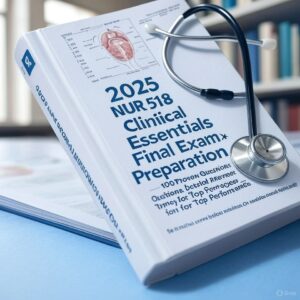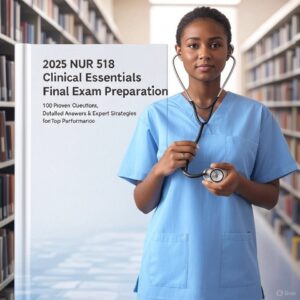-
100 Proven Questions: Practice with carefully selected questions to test your clinical knowledge.
-
Detailed Answers: In-depth explanations to reinforce understanding of key concepts.
-
Expert Strategies: Proven techniques to optimize your study and exam performance.
-
Focused for NUR 518: Tailored to the Clinical Essentials curriculum for 2025.
-
Performance-Driven: Designed to help nursing students achieve top scores.
Preview
1. A nurse is caring for a patient who has just had major abdominal surgery to
resect a portion of his colon. What is the most reliable sign that the patient has
significant postoperative pain?
A. The patient rates his pain a 7 on a scale of 0 to 10.
B. The patient winces and guards the area as the nurse gently palpates the abdomen.
C. The patient is having trouble sleeping and has become irritable.
D. The patient is moaning softly and frowning, with a pinched expression on his face.
Correct Answer: A. The patient rates his pain a 7 on a scale of 0 to 10.
Rationale: The most reliable indicator of significant postoperative pain is the patient’s
self-report of pain intensity. A pain rating of 7 out of 10 is considered moderate to severe
pain, making this the most reliable sign.
2. What will the nurse instruct nursing assistive personnel (NAP) to do regarding the
management of a patient’s pain?
A. “Let me know at least 30 minutes before you transport her so I can administer her
analgesics.”
B. “Be sure to keep the room temperature high and the TV on at all times.”
C. “Be sure to tell me if you notice grimacing, guarding, or any unusual behavior.”
D. “I’ve given her some medication; please report to me whether it seems to have
relieved her pain within an hour or so.”
Correct Answer: A. “Let me know at least 30 minutes before you transport her so I
can administer her analgesics.”
Rationale: Proper timing of analgesic administration is essential to managing pain
effectively. By notifying the nurse 30 minutes in advance, the NAP ensures that pain
relief is given before any discomfort occurs due to transportation.
3. Which observation indicates that a patient’s analgesic has been effective in
managing pain that she rated a 6 out of 10 on a pain rating scale before the
intervention?
A. The patient is seen quietly reading a magazine.
B. The patient rates her current pain as 3 out of 10 on the pain rating scale.
C. The patient is overheard telling her family that she is “feeling better today.”
D. The patient is observed sleeping, with a respiratory rate assessed at 18/minute,
compared with 22/minute before the intervention.
Correct Answer: B. The patient rates her current pain as 3 out of 10 on the pain
rating scale.
Rationale: A decrease in pain rating (from 6 to 3 out of 10) clearly indicates that the
analgesic has been effective in managing the patient’s pain.












Reviews
There are no reviews yet.